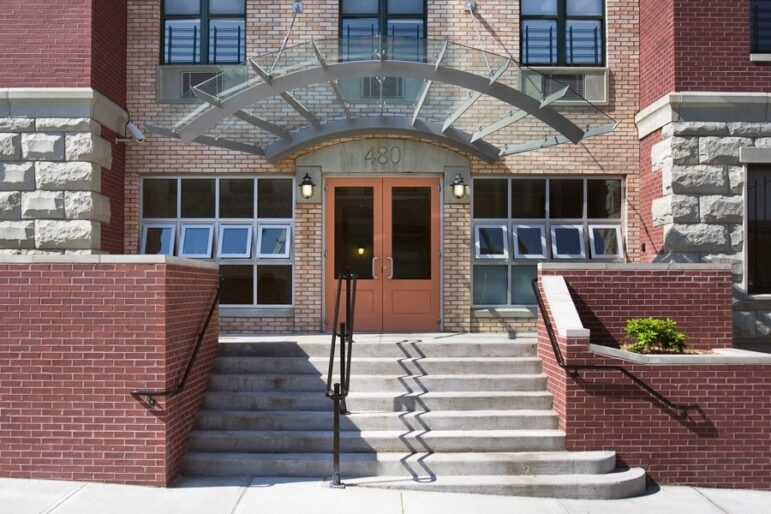
Opinion: Securing the Future of New York’s Supportive Housing
“New York is a national model of supportive housing, which has been proven time and again to be among the most successful methods of ending chronic homelessness. But the system has grown unwieldy, thanks to the vast disparities in available services, funding, and unit maintenance.”
Diane Louard-Michel/Lantern Community Services
A supportive housing building on East 176th Street in the Bronx.
CityViews are readers’ opinions, not those of City Limits. Add your voice today!
Members of the New York City-based nonprofit St. Francis Friends of the Poor, who pioneered permanent, affordable housing with on-site voluntary services for formerly unhoused individuals, wouldn’t recognize the expansive, complicated, and multifaceted system that grew from the seeds they sowed 44 years ago.
Today, New York has than 62,000 supportive housing units. They span 18 unique programs, are overseen by nine government entities, and encompass 46 specific population categories, providing homes and support to at-risk populations in every county across our state.
A first-of-its-kind report from the Supportive Housing Network of New York (the Network) revealed the significant funding discrepancies between these programs, which makes it difficult to ensure tenants get the quality housing and services they need and also to pay essential social services workers the competitive and sustainable wages they deserve.
Of particular concern is the stark contrast between the first state-funded initiative, the New York State Supportive Housing Program (NYSSHP), and the 2016 Empire State Supportive Housing Initiative (ESSHI). The failure of the governor and state lawmakers to address this discrepancy in the recently enacted 2024-25 budget was a significant oversight that could have a devastating impact on vulnerable formerly homeless individuals and families.
NYSSHP began in 1987 and has helped generations of vulnerable individuals–including survivors of domestic violence, seniors, families experiencing homelessness and those facing mental health or substance use challenges, among others. As a resident of the NYSSHP-funded Kathlyn Gardens, quoted in the Network report, said: “This place has given our mom the ability to raise us safely.”
Despite NYSSHP’s undeniable successes, stagnated funding threatens to erode its impact. This is particularly glaring when NYSSHP, which provides $2,964 for an individual and $3,900 for a family per year for services only, is compared to ESSHI, whose residents receive $25,000 per household per year for services.
This year, the Network asked the state to include revenue in the budget to convert 9,000 homes funded solely by NYSSHP to the ESSHI program. These units are most at risk of coming offline at a time when the homelessness and affordability crises are mounting by the day, and the loss of even a single unit is something we simply can’t afford.
The State Senate included $32 million in its budget resolution to pay for the first year of what the Network envisioned as a five-year conversion. But somehow, these critical funds weren’t included in the final budget deal. This is, quite frankly, inexplicable.
Many NYSSHP buildings and other supportive housing programs are in buildings that are decades if not centuries old. The Network’s report found that only 6 percent of congregate buildings over 15 years old have been rehabbed.
This is particularly concerning for NYSSHP’s relationship to the Supportive Housing Preservation Program capital funding under NYS Homes and Community Renewal (HCR), which aims to preserve 3,000 supportive housing units in five years. Without the conversion from NYSSHP to ESSHI rates, the long-term underwriting for these deals very rarely works. Both tenants and staff pay the price of leaky roofs, faulty elevators, and outdated facilities that are not handicapped accessible.
New York is a national model of supportive housing, which has been proven time and again to be among the most successful methods of ending chronic homelessness. But the system has grown unwieldy, thanks to the vast disparities in available services, funding, and unit maintenance. Some buildings boast new, modern amenities while others are in desperate need of repair.
As we approach the 50th anniversary of supportive housing, it is time we reflect on how far the movement has come and chart a course for its continued improvement well into the future.
Albany must do the right thing by NYSSHP tenants and pass a stand-alone bill in the post-budget session to convert those 9,000 units to ESSHI. Now is the time to take the fundamental promise of supportive housing–that all residents deserve equal resources and care–and modernize and improve the model.
By doing so, we can finally help New York end homelessness–and we cannot afford to delay.
Pascale Leone is the executive director of the Supportive Housing Network of New York (the Network).
The post Opinion: Securing the Future of New York’s Supportive Housing appeared first on City Limits.


